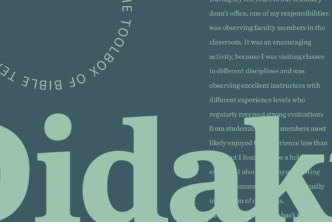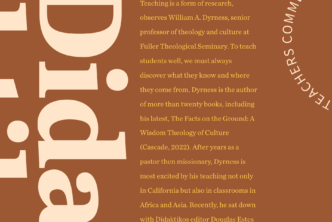Robert Smith Jr. on Cultivating Imagery to Satisfy the Narrative Mind
In the twenty–first century world of theological education, preaching can seem an antiquated exercise that no longer speaks well to a culture immersed in social media and increasingly skeptical of the role of religious proclamation in the public square. But what is theological teaching without biblical preaching? Enter Robert Smith Jr., the Charles T. Carter Baptist Chair of Divinity at Beeson Divinity School, who has spent a lifetime preaching so as to teach, and teaching so as to help others preach. Smith spoke recently with Didaktikos editor Douglas Estes about visual teaching and the importance of theological conversation partners.
ESTES: With such a distinguished teaching record, what does teaching well mean to you?
SMITH: Teaching well means to me that one teaches holistically. What I mean by that is listening to the words of Paul at the leadership conference held in Miletus. In Acts 20:27 Paul says, “I have not hesitated to declare to you the whole counsel of God.” And this is my definition of the whole counsel of God: the broad and overarching concept that unites and ties together every passage of Scripture so that it relates to the overall plan and comprehensive purpose of God revealed in the Scriptures by the Holy Spirit in order to magnify Jesus Christ.
So I want to teach in such a way that there is intra-trinitarian presence in teaching. If it is about the overarching plan of God, it is about the Holy Spirit revealing the Scriptures, and it is about Christ being magnified. So when I teach, I want people to see the triune God, and I want to teach in such a way that there is intertextuality all for the purpose of magnifying Christ. After all, that is the purpose of the Spirit. “When the Spirit has come,” Jesus says in John 15:26, “he will testify of me” and not about himself. So that’s what I mean by teaching well.
I want to teach the whole Bible in one session—without going all throughout the Bible quoting every Scripture, but so that my students see the overall plan, the comprehensive purpose of God revealed in the Scriptures by the Holy Spirit in order that Christ is magnified.
ESTES: In contrast to a grand vision, many students in our classes have become accustomed to communication in 280 characters or less. They live in a world where short bursts of communication make it hard to develop anything. How do we teach well when that is our audience?
SMITH: Well, what I want to do is to teach visually, because images often convey in a shorter time the truth of what we try to convey in just mere abstract words. So I want to visualize it. I want to paint the picture. I want our students to see what we’re talking about and not just hear what we’re talking about. I put it this way: say what you see so clearly that your students can see what you’re saying. Turn the ears of abstraction into the eyes of visualization—and Jesus, of course, was the best at that. “The kingdom of heaven is like …” He used similes. He used metaphors.
James A. Sanders taught canonical hermeneutics. He said that biblical characters do not primarily serve us as models for morality, but rather as mirrors for identity. That’s what Paul is trying to get across, I believe, in Romans 15:4. Those things that were “written aforetime were written for our learning, that we through patience and comfort of the Scriptures might have hope.” So Paul is painting pictures in Romans. What does justification look like? Well, I’m going to give you two examples. Biographically, we’ll start with David and then we’ll move on to Abraham. And as one looks at the life of Abraham and looks at the life of David, then one can see that justification is something that takes place outside of us, that is not accomplished through our works. Abraham is justified because he believes God before he is circumcised. And David is justified in spite of his sin: Blessed is the man whose transgressions are forgiven and whose sin is covered (Ps 32:1).
So I want to be able to present biblical concepts more concisely, more succinctly by visualization. I want to be able to help students see what I’m trying to say. And since their attention span is not as long as someone like me, then I want to promote Haddon Robinson’s Making a Difference in Preaching. He says he really wanted to invest his life in preaching because he wondered what the difference was between a preacher who preached a sermon of sixty minutes but it seemed like it was twenty minutes and a person who preached a sermon in twenty minutes but it seemed like it was sixty minutes. I think that’s possible—I really do. To be that versatile, that graphic, that engaging, so that students can take in more when we have something to say—rather than just have to say something—and it becomes compelling.
ESTES: I’m editing a book on the tree of life in various biblical and theological contexts. In writing my chapter on Revelation, it struck me that even though the tree of life is such a powerful image, we sometimes still treat it as merely literal. Is the Bible itself full of powerful images that we seem to gloss over too quickly in our teaching?
SMITH: There’s no ifs, ands, or buts about it. It’s what Jesus is saying. He says to Nicodemus, “Here’s the concept, Nicodemus. You’ve got to be born again.” Because Nicodemus misses it. He’s speaking abstractly; he’s speaking about biological reversion. Jesus says, if you’re not born again, you can’t even see the kingdom of God (John 3:3). The same thing with Pilate in John 18:38. Pilate asked the question, “What is truth?” That’s a great philosophical abstraction, but he’s standing right before truth. Jesus says, “I am the truth.” So I think we miss the image because we think we can transport it and convey it abstractly in such a way that people are impressed—that’s part of the problem—rather than people being engaged and people being caught up in understanding what you’re trying to say by you showing them what it looks like.
ESTES: Speaking of engagement, as we were chatting before the interview, you mentioned that tenere is the Latin word for “entertain,” as in “to hold the attention of.” I have many students who think and write with a blog-like style. Getting them to think abstractly and visually and theologically—how do we do that? What are some methods to hold the attention of students that are effective without being faddish or cliche and without losing the importance of the message?
SMITH: I think we have to be rooted without being restricted. I mean rooted in solid, orthodox, theological, foundational truths that are not negotiable. Rooted but not restricted in terms of how we present those truths, how we present those texts. John the Baptist preached and he brought a deductive sermon to Herod Antipas. The sermon was, “Herod Antipas, you committed adultery. It’s wrong for you to have your brother Philip’s wife.” And he lost his head. Nothing inductive about it. Straightforward deduction. And that’s right, but that’s not the only way to preach about adultery.
Nathan preaches an inductive sermon to David and tells him about a man who had some unexpected guests. And instead of this rich man getting one of the lambs from his own stock or stalls, he chooses to take away the ewe lamb, the female lamb, that grew up in the family of this man. He snatched it away, killed the lamb, and served lamb chops to his guests. And Nathan asked, “Now, what do you think about this, David?” The Bible says David was wroth, he was angry. And what should happen to this man? David said he should be killed.
Now, David has no idea where Nathan is going with that. Then Nathan says, “You are the man.” It’s induction, where you reserve the conclusion for the end; with deduction, you present the conclusion or the proposition in the beginning. And both Nathan and John the Baptist preached on adultery in ways that were rooted in the Bible. But they were not restricted in terms of their approach, in terms of their form.
The Bible has all kinds of literary genres. I don’t know why we think that we have to present every message in the same literary form. I think that the literary form in Scripture is inspired. We have prophecy, we have law, we have wisdom, we have gospel, and on and on. So why shouldn’t we take the form that Scripture gives us, rather than bringing our own form to the text? And it’s always the same form, whether people hear us every Sunday, if you will, or hear us in a classroom. We become so predictable that we become unengaging, and we become boring rather than take something that offers us a variety. We are not restricted in the way we present it, but we are rooted in the truths that we present.
ESTES: As I was listening to you, I was thinking that the variety and complexity of the Bible is one of the things that makes it wonderful. But we like to simplify everything because it’s just easier.
SMITH: Exactly. I was thinking about the Sermon on the Mount. Look how Jesus presents that. In fact, when it ends—verses 28–29 of Matthew 7—the people were astonished at these sayings, how he presented his material, because he taught them as one who has authority, and not like one of their teachers, one of their scribes and Pharisees. So he presents images. Two roads and two houses and a closet to pray out of, and light and salt, and on and on as these people sit on the hills.
ESTES: While you have a Baptist background, you are a proponent of the Wesleyan Quadrilateral of Scripture, reason, tradition, and experience. How does that speak to teaching methodology?
SMITH: It’s holistic. Jesus says in Matthew 22:37, “You shall love the Lord thy God with all your heart, all your soul, and all your mind.” So it’s a matter of tradition. Tradition is significant; it’s not the final word, but it’s significant. Richard Baxter, the Puritan preacher, wrote The Reformed Pastor, in which he says, “In things that are essential there must be unity”—like the orthodox doctrine, the incarnation of Christ, the bodily resurrection of Christ, the bodily return of Christ, the biblical miracles, on and on and on. We have to agree on those. Those are not up for grabs or negotiation. So that’s important. That’s my tradition and that’s what my Baptist tradition taught me.
Reason is the head. The head is not enough, but I do love him with all my mind. So it must not be a presentation or an orientation that’s based only on experience. First Peter 3:15 says I must always be ready to give a reason, an apologia, a tenable defense for the hope that lies in you. So the head is important in terms of reason.
Experience is important. I must experience my exegesis, not just know it. I need to experience it so much so that, after I lecture or preach or present, I have said about me what was said about Peter and John in Acts 4:13: We said that these men were ignorant, but we could tell that they had been with Jesus. Then, verse 20 of chapter 4, Peter says to those who wanted them to stop preaching in the name of Jesus, “We cannot help but speak the things we’ve seen and heard.” We’ve seen something. We’ve heard something. In other words, we’ve experienced something. In other words, we have walked with Jesus himself. So we’re not just preaching about him. We are preaching him because we have experienced him.
And then finally, this matter of the Scriptures—that’s the ultimate prize. We preached the Scriptures there. For as Isaiah 40:8 says, “The grass withers, the flower fades, but the word of God shall stand forever.” And so the Wesleyan Quadrilateral is important to me, and I must have those things in order. The first three are fine, they’re great, but the fourth one is the final—the Bible, the word of God. “Forever, O Lord, thy word is settled in heaven” (Ps 119:89).
ESTES: As theological educators try to cover all of the various facets that make teaching powerful, we also remember the power of story. In a narrative world, what do we need to pay attention to as we teach?
SMITH: Haddon Robinson, years ago, was interviewed in Preaching magazine. The title of the piece was “Expository Preaching in a Narrative World.” My brother Dr. Robinson is in heaven now, but everybody knows he was an expositor par excellence. But what you’re saying is that the world is narrative, and so what we need to do is to preach the text in a way that the narrative mind can be able to hear the message and see the message. As I was saying to you before, this idea of painting the picture is huge. And looking at the Old Testament, it is approximately seventy-seven percent narrative. So why do we try to present the Old Testament in three points and a poem, and why do we always present it abstractly rather than present it narratively? I think it’s very, very important that that is done.
Marcion, of course, was excommunicated from the church in AD 144 in Rome. Why? He did not say that the same God who inspired the New Testament is the same God who inspired the Old. So he rejected the Old and a few of the books in the New Testament. Well, the same God who wrote the Old is the one who wrote the New. And they coexist because all of the books have the imprimatur, have the signature, of God on them. …
I think that what is missing is not so much us giving the material or giving lectures; I think we need to give more of ourselves. In Mark 3:13–15, Jesus, when he called his disciples, the first thing he did was he called them to be with him. Before he even started to send them out to preach and to cast out devils, it was discipling students, spending time with them. Which is threatening for some, because we think it’s going to leave us with less time for writing (which I hope we’ll talk about it in a moment). But here’s Jesus, who is the personification of the wisdom of God, spending time with his disciples before he even sends them out. I think we need to spend more time and pour ourselves into our students, more than just presenting lectures and giving presentations from the lectern.
ESTES: Tell me a little bit about your personal ministry outside the academy and how that’s influenced your teaching in the academy.
SMITH: I have been preaching now for fifty-two years, and almost thirty of those years have been spent in teaching. I have married the pulpit with the lectern, preaching with teaching. Preaching for me provides practicality for what I’m doing in the classroom, so that my students will have a sense of my teaching as being credible. This is an individual not just teaching from a book and giving us various formulae. This is someone who preaches this and does this forty-eight Sundays out of a year, fifty-two years straight. Here’s someone who sees this as being practical, because he’s been in the trenches. I see that preaching outside of a classroom keeps me grounded in my purpose.
What is my purpose? What I do in the classroom is for the service of the church. And therefore, I need to be in the church to know what I need to teach my students, so that I know what they are facing, I know the challenges, because I’m out there in the churches. Otherwise, I fail to be what I call “one-thing-ified”—this one thing I do. We have divorced two necessary elements that God has joined together—preaching in churches and teaching in the classroom—and I think they have to be brought back together again, lest we become ivory-tower theologians and preachers who have no sense of what’s going on in the church. And then we’re not preparing students for the church, we’re just preparing students for grades, to learn more, to be stellar thinkers but not involved—as I was saying about Jesus with his disciples—not involved with people outside the church. Paper but not people, and both go together.
ESTES: I know there are different types of professors and theologians who have different perspectives. But it seems to me that, if you have the chance to do personal ministry outside the classroom, it actually gives you a framework to be able to come up with narrative aspects for teaching the Bible. If you’re only approaching it as a text without any involvement in that text, it’s really hard to think about how it fits into the world and how to put it in a narrative context. But if you’re out there living it, then the narrative aspects of it will come to mind much more quickly. What do you think?
SMITH: Let me tell you what you just said. You said everything that I believe and everything that has been in me for fifty-two years. That’s the kind of preacher Paul was. …
I’m talking about effectiveness. You know what restaurants do? Chefs will have some food, and they will think about putting it on the menu. And so they will have people to come in, taste their food, see what they like, if it’s good or not—and if it passes the test, then it will go on the menu. How can you have a menu unless you have a clientele and know what that clientele needs? I’m not talking about felt needs, but I’m talking about real needs. And that’s what I think is very, very important. Otherwise, we are preaching—once again I keep using this word—in abstraction rather than in concretion. And knowing that what we have to say just connects with the jugular vein of where people are—because shepherds must smell like their sheep, and you can’t smell like your sheep if you’re not around your sheep.
ESTES: Let’s shift gears and talk about publication. When is publication important?
SMITH: Reciprocity is important. I have been benefited and helped by the writings of others whose voices have been hushed. And I’m reading the writings of various persons, like my conversation partner the great Helmut Thielicke, who died in 1986, and I did my dissertation on him starting in 1990, four years after he died. His publication took and fed me, and now everything I do theologically, homiletically, hermeneutically, goes through him. I talk with him based on his writing. I talk with him because he’s a major thinker within the twenty-plus centuries of our church history.
Longevity is important, because my death will come. And after I die, my voice—hopefully, if I publish—will still be heard. People will be helped by it.
I like what Charles Bartow, who taught preaching and worship at Princeton Seminary years ago—I like what he said about turning the ink of the literature, whatever you’re reading, into blood.1 In other words, experience it. Turn the ink of literature into blood. That’s great. But in fact all you have is just blood. One day blood will stop flowing, we’ll die, and then there will be nothing that people can gain because you’ve left nothing. What you’ve told people orally—yeah, that’s perpetuated and carried on to other people, and that’s great. But I really like what T. S. Eliot says: “The purpose of literature is to turn blood into ink.” Turn the blood of life into ink so much so that once you have experienced the blood in life you turn it into the ink of writing and you pass it on. And you have books that others can read, like John Calvin. His Institutes of the Christian Religion is the most far-reaching theological compendium in Protestant theology that we have. Now, he died in 1564. His last publication, as I recall, was a revision of the Institutes in 1559. You’re talking about a compendium that’s close to being five hundred years old. So I think it’s really important for us to leave something behind for those who follow us, because someone has left something behind for us so that we can perpetuate sound teaching and sound theological and biblical preaching.
ESTES: If you had a young professor come to you and ask you for one piece of advice, what would you say?
SMITH: I’ve kind of alluded to that, but I would say this to a professor: make sure that you cultivate a theological conversation with a credible conversation partner. I’m talking about someone who is massive in terms of having his hand or her hand on the pulsating heartbeat of what’s going on in church history, what’s going on in the theological world. My theological partner, as I was saying, is Helmut Thielicke. I cannot tell you how invaluable he is. He has sixty-six books, so anything that comes out that has not been published, at least, in English, I’m going to read that too. I think that’s huge, because that becomes the DNA of a professor—particularly a young professor—and he or she will be able to reap tremendous benefits rather than trying to read everybody. No one can read everybody, but you can read as much, if not everything, on someone that has stepped in the theological world, and you can go deeper in that person. And that person made connections with other individuals you’re interested in and will keep you in touch with significant and credible theologians. Bonhoeffer is a major one, and probably more than anyone else he’s the one that many of my students have gravitated toward.
ESTES: Any final thought for our readers?
SMITH: The only thing I would want to say is this idea of Luther being concerned about the word of God being engraved in the hearts of people to the explanation of Scriptures that we must follow what Paul says in Acts 20:20. He says, “I kept back nothing that was profitable unto you.” Now, our presentations maybe are always profitable, but they’re not necessarily immediately palatable. They don’t always taste good immediately, but they’re always profitable. Second Timothy 3:16 says all Scripture is given by inspiration of God, and is profitable for doctrine, for reproof, for correction, for instruction in righteousness, on and on and on. So the profitability is always there. The palatability is not immediately there.
My mother had one menu. If you didn’t want what’s on the menu, you just went to bed hungry. That’s all. She didn’t have an additional back up menu. I wanted something that was palatable in terms of food all the time, but not profitable. So I wanted french fries and hot dogs and hamburgers and things like that—onion rings. Mama, basically, was saying, “I refuse to do that. Those may be palatable, but they’re not profitable. You need some squash, and you need some okra, and you need butter beans.” And I said to myself, as a young black child, “Once I get out of this house and get grown up, I’ll never have another piece of squash, another butter bean enter into my mouth.” But mama kept serving those things to me, and that which is not palatable even though it’s profitable became more palatable. So I developed an appetite for it. And when I got out of our house, some of my favorite foods then and now are still the same—squash, butter beans, and okra.
I would want professors to keep giving your people that theological serving that is always profitable. Though it may not be palatable to the students, if you keep giving it to them they will develop an appetite for it, and they will love the palatability—and profitability—of what you are giving to them.
Didaktikos is free for faculty in theological education. Sign up today.






